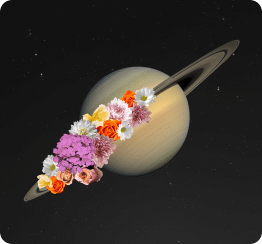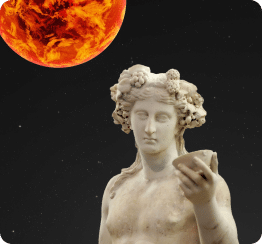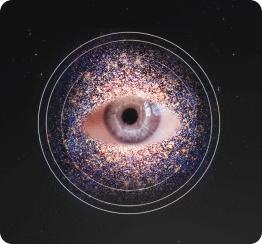When is a planet really ‘cazimi’
Traducción del blog original escrito por Anthony Louis. Traducción generosamente realizada por Belen Landi.
Cuándo un planeta es realmente cazimi
[When is a planet really ‘cazimi’]
En marzo de 2021 muchos sitios astrológicos publicaron artículos sobre un supuesto fenómeno venidero de un Venus cazimi el 26 de marzo a 5° 50´de Aries en el zodíaco trópico. La palabra cazimi viene de un término árabe que significa: en el corazón del Sol. La conjunción de Venus con el Sol el 26 de marzo de 2021 NO era un ejemplo de Venus cazimi porque Venus estaba a 1 grado 21 minutos de latitud debajo de la eclíptica y no se superpuso al cuerpo del Sol. Primero, tomé conciencia de la importancia de prestar atención a la latitud planetaria en astrología clásica cuando leí la traducción de Pingree de Doroteo a finales de 1970.
William Lilly definió “cazimi” como el centro del planeta que está a menos de 17 minutos del arco desde el centro del Sol.
Más adelante en su texto, Lilly da un valor de 16 minutos de arco: “cuando un planeta está a 16 minutos del Sol, se dice que está en cazimi…” (CA 300). Esta definición es un poco menos precisa.
“Un Planeta está en el corazón del Sol, o en Cazimi, cuando no se le quita 17 minutos, o está dentro de los 17 minutos adelante o atrás …” (CA 113)
Esta definición tiene sentido porque el Sol tiene un diámetro angular de aproximadamente medio grado o, más precisamente, entre 31′27″ y 32′32″. Por tanto, medio diámetro del Sol, visto desde la Tierra, mide entre 15’44” y 16’16”, entonces, el centro de un planeta que está dentro de este rango de distancia desde el Sol, generalmente, se superpondrá con el cuerpo del Sol, es decir, cuando el centro del planeta es menor que 17´desde el centro del Sol.
La medida precisa de cazimi dependerá del día del año y del diámetro angular del planeta involucrado. Desde un punto de vista de observación en la Tierra, cazimi y se extienden hasta 16’16 “desde el centro del Sol, lo que explica que Lilly a veces escriba” dentro de 17 minutos “y en otro momento escriba” dentro de 16 minutos “de arco. Si tenemos en cuenta la refracción atmosférica, el cuerpo del Sol puede parecer tener un diámetro angular de 34 ′ de arco, por lo que cazimi se extendería hasta 17 ′ desde el centro del Sol, lo cual es consistente con la definición de Lilly en la página. 113 de la Astrología Cristiana.
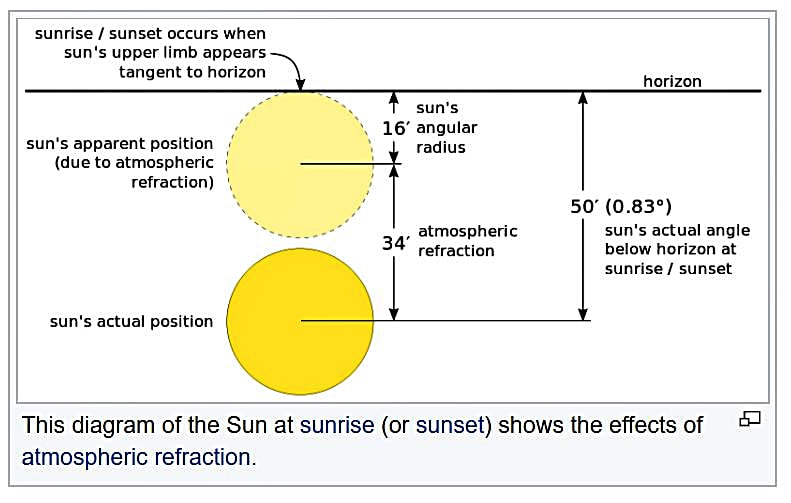
Desafortunadamente, Lilly no clarificó que estar cazimi aplica a la distancia desde el Sol en ambas longitud y latitud eclíptica, lo que hace que el estado cazimi de un planeta sea de ocurrencia extremadamente extraña. Más comúnmente, un planeta en conjunción al Sol en longitud no se superpone al cuerpo del Sol en latitud y, por tanto, no es cazimi (en el corazón del Sol).
Según William Lilly, un planeta cazimi, yace en el corazón del Sol, por ende, se vuelve más fuerte y benéfico como resultado de su aumento en fortuna (CA 300). Los seguidores de Lilly, quienes no conocían que la definición aplica a ambas longitud y latitud eclíptica, con frecuencia, se sorprenden cuando un supuesto planeta cazimi no confiere mucho beneficio al consultante. Con el pasar de los años, en muchas cartas horarias, donde los significadores aparecían cazimi, me decepcionaba ver que las implicaciones de un planeta cazimi no se manifestaban en el resultado de una carta, hasta que me di cuenta que había estado ignorando la latitud del significador y, solamente, consideraba la cercana conjunción al Sol en la longitud eclíptica.
El astrólogo del siglo 13 Guido Bonatti, a quien Lilly ama citar, hace la definición bastante clara: “Y cuando un planeta esté con el Sol en un grado y haya 16´o menos entre ellos, en ambas latitud y longitud (que raramente sucede), se dice que están unidos, entonces, se hacen fuertes, porque se dice que están forjados en el Sol, es decir, en el corazón. ” (Ben Dykes traducción de Liber Astronomiae, 2007, p.211).
La definición de Bonatti básicamente significa que con el hecho de estar cazimi, el centro del planeta debe estar dentro del cuerpo del Sol. Los modernos tienden a subestimar la remarcable habilidad de observación de los astrólogos antepasados. Si los antiguos hubiesen tenido los telescopios que tenemos ahora, hubiesen ilustrado la definición de cazimi con un diagrama como el siguiente de la NASA:
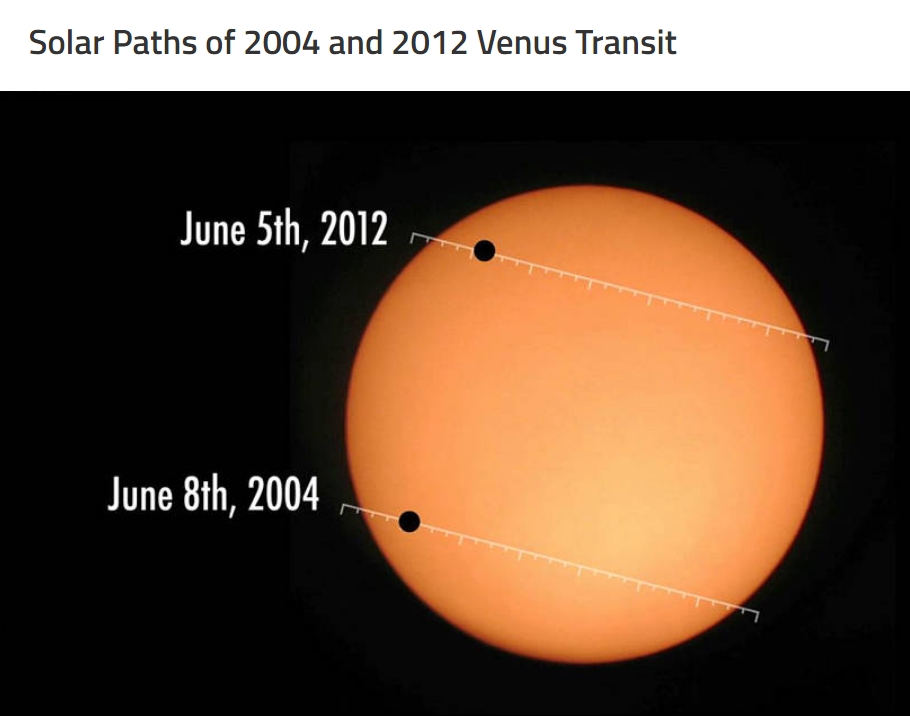
El texto que acompaña de la NASA iría como sigue:
“Un tránsito de Venus sobre el Sol sucede cuando el planeta Venus pasa directamente entre el Sol y la Tierra y se vuelve visible contra (y, por ende, oscureciendo una pequeña porción del) disco solar. Durante el tránsito, Venus puede verse desde la Tierra como un pequeño disco negro moviénsose a través de la cara del Sol.
Los tránsitos de Venus están entre los fenómenos astronómicos más raros de predecir. Ocurren en un patrón que se repite cada 243 años, con pares de tránsitos de ocho años de separación por largos lapsos de 121,5 años y 105,5 años. Este tránsito del mes está enmarcado en el par 2004-2012. El primero, ocurrió el 8 de junio de 2004. El segundo, ocurrirá el 5 de junio de 2012.
Después de 2012, los siguientes tránsitos de Venus serán en diciembre 2117 y diciembre 2125.”
Si ponemos el texto de Bonatti en lenguaje moderno, podemos decir que Venus cazimi es un tránsito de Venus a través del Sol. Y como la NASA clarifica, tales tránsitos de Venus a través del cuerpo del Sol son “extremadamente raros”. Ocurren en un patrón que se repite cada 243 años con un par de tránsitos de ocho años separados por períodos largos de 121,5 y 105,5 años.” Hubo Venus cazimi en 2004 en par con 2012, con otro par que ocurrirá en diciembre de 2117 y 2125. No hubo tránsito de Venus a través del Sol en marzo de 2021, a pesar de que algunos sitios astrológicos lo dijeron. No puedes creer todo lo que leas publicado. Entonces, si has estado leyendo conjunciones de planetas con el Sol como planetas cazimi, sin considerar la latitud, has estado interpretando erróneamente las cartas horarias y brindando información equivocada a los clientes.
Los tránsitos de Venus al Sol, en el sentido de la NASA, se refieren a la conjunción inferior de Venus con el Sol, durante el cual el cuerpo de Venus se vuelve visible para los observadores en la Tierra en una forma asombrosa. (Aparte, Bruce Scofield en su libro How to Practice Mayan Astrology [Cómo practicar astrología Maya], nota estos eventos de interés, que se correlacionan con la conjunción inferior de Venus que “frecuentemente se caracteriza por errores humanos impulsivos que llevan a nivelar un golpe de algún tipo.” Esto suena mucho más a Venus combusta que a estar cazimi, fenómeno de extraña ocurrencia). La idea de cazimi, ¿también aplica a Venus en la conjunción superior con el Sol si el cuerpo de Venus está completamente escondido por el cuerpo del Sol y, en un sentido, está súper combusta y más imposible de ver desde la Tierra?
Si tomamos seriamente la definición de Bonatti, entonces, necesitaremos pensar nuevamente la definición de combustión. Como pueden ver en la imagen de la NASA, una vez que Venus yace fuera del disco del Sol está completamente oscurecida por los rayos del Sol y está combusta, incluso si está en exacta conjunción con el Sol en longitud eclíptica. Por tanto, los planetas muy cercanos al Sol están combustos a menos de que se superpongan al cuerpo del Sol en ambas latitud y longitud. Si tal es el caso, la conjunción de Venus/Sol del 26 de marzo de 2021 estaba a 1 grado 21 minutos de distancia del centro del Sol en latitud al momento de la exacta conjunción en longitud.
El siguiente diagrama viene de un artículo publicado en harvard.edu site. Lista las conjunciones inferiores de Venus desde 1961 a 2023, junto con la latitud de Venus durante cada conjunción inferior. Es inmediatamente aparente que las únicas dos conjunciones en las que el cuerpo de Venus transitó el cuerpo del Sol ocurrieron en 2004 y 2012. En todas las demás fechas, Venus estaba combusta al Sol en latitud durante la conjunción inferior al Sol. Vean que en muchas fechas, Venus está separada a 8 grados o más del centro del Sol en latitud y no puede incluso alcanzar la definición de estar combusta al Sol.
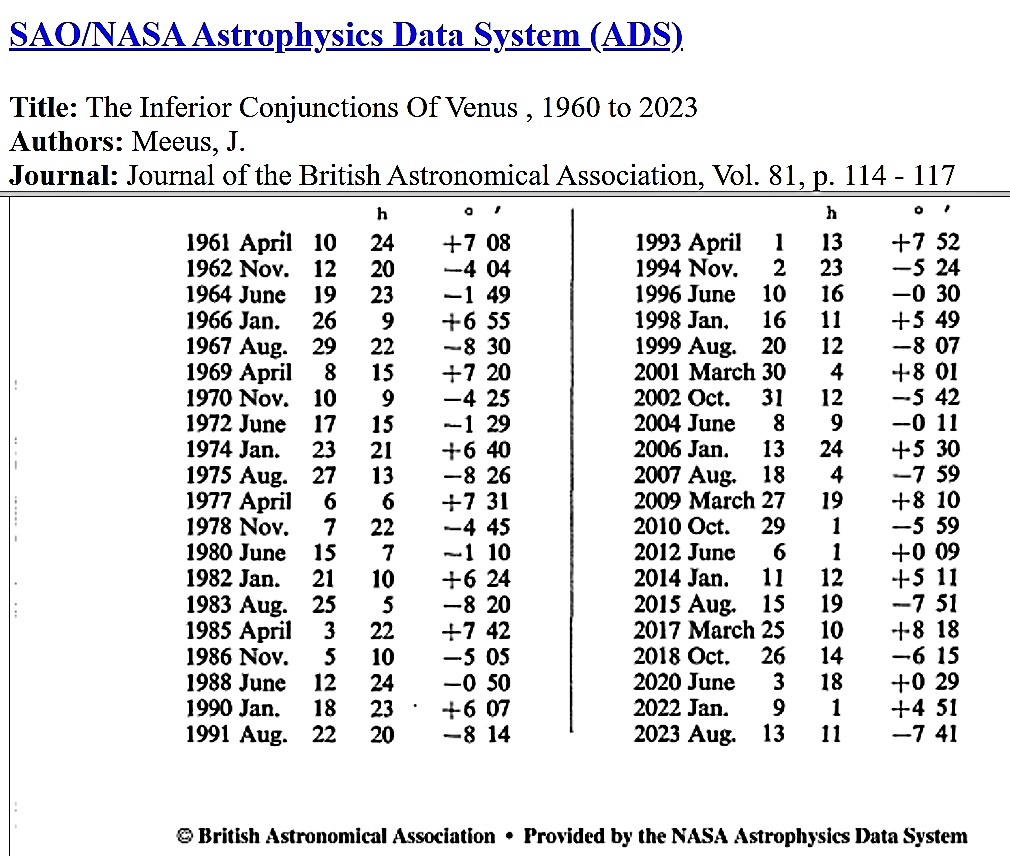
Apéndice (6 de julio de 2021): Lyuben Meshikov llamó mi atención un artículo de article by Patrizia Nava about cazimi el cual llega a conclusiones similares:
EN EL CORAZÓN DEL SOL
El rol de la latitud en la definición de cazimi
Presentado en la conferencia KIA, Kolkata, 1 de enero, 2018.
Una búsqueda en Google también reveló una copia de este artículo en línea [online] https://www.astro.com/astrology/ivccn_article180927_e.htm#_ftn6
Parece que Patrizia Nava ha tenido las mismas experiencias con cartas horarias. Los significadores que aparecen cazimi a menudo decepcionan los resultados para el consultante. Es probable que el tema sea porque no estamos teniendo en cuenta la latitud y, por ende, etiquetamos planetas como cazimi cuando en realidad son combustos.
Apéndice (7 de julio de 2021): Más observaciones de la literatura, la comprensión de Bonatti sobre Abu Ma’shar.
Rhetorius y Sahl definen cazimi o “en el corazón del Sol” a un planeta que está en el mismo grado, presuntamente, a través de la eclíptica, como el Sol. Esencialmente esta es una conjunción ‘partil’ (partil significa en el mismo grado individual de los 30 grados distintos dentro de un signo) de un planeta con el Sol.
Abu Ma’shar, en la discusión de los ciclos sinódicos de los planetas relativos al Sol, parece referirse a la distancia de los planetas a través de la eclíptica, por tanto, cazimi significa no más de 16′ del arco desde el Sol en la eclíptica. Una vez que los planetas se mueven más que 16′ del Sol en la eclíptica se consideran quemados o combustos. Para los planetas inferiores, la combustión dura hasta que estén a 7 grados de separación del Sol en la eclíptica. SIN EMBARGO, Abu Ma’shar observa que para VENUS, incluso cuando está cazimi y dentro de 1 minuto del arco desde el Sol en la eclíptica:
“a veces va a ser vista en el este u oeste mientras está todavía con el Sol en 1′ y es como cuando está en el máximo de su latitud… entonces cuando Venus está en esta condición de gran latitud y visibilidad NO ES LLAMADA ‘quemada’ sino que es llamada como que está ‘apareciendo’ hasta que la latitud sea menor a 7 grados y esté un poco cerca del Sol en latitud; entonces, quizás, no será visible y será llamada ‘quemada’ en aquel momento.” (Dykes, Great Introduction of Abu Ma’Shar [Gran introducción de Abu Ma’Shar] , 2020, p.418, énfasis realizado por mi).
¿Hay una inconsistencia lógica en la cita anterior sobre el pensamiento de Abu Ma’shar? Cuando Venus está a más de 7 grados de la longitud o latitud eclíptica desde el Sol, no es llamada “quemada”, pero cuando es visible a 8 grados o más de latitud desde el cuerpo del Sol y obviamente no está en contacto con el cuerpo del Sol, es llamada cazimi. ¿Cómo puede estar un planeta en el corazón del Sol cuando aquel planeta yace a 8 grados del cuerpo del Sol?
Por otro lado, podemos entender que Abu Ma’shar está indicando que para cazimi se debe considerar la latitud, según lo comprendía Bonatti. Ma’shar comienza por decir que cuando Venus está dentro de 1′ del arco desde el Sol en la eclíptica pero está a más de 7 grados de distancia en latitud, Venus puede ser visible y, por ende, no estar combusta (implica que Venus no está en el corazón del Sol). Solamente cuando Venus está dentro de los 16′ del arco del Sol en ambas longitud y latitud eclíptica, puede, Venus, entonces, ser considerada en el corazón del Sol. La última visión es cómo Bonatti entendió el texto de Ma’shar.
En resumen, cuando Venus está cerca del Sol y conjunta con el Sol dentro de 1 minuto del arco en la eclíptica, puede estar en una de tres condiciones, según Abu Ma’shar:
1) más de 8 grados de latitud desde el Sol (mientras está exactamente conjunta con el Sol en la eclíptica), Venus está visible y no combusta, pero “apareciendo”.
2) menos de 7 grados de latitud desde el Sol pero más de 16′ de latitud desde el Sol (mientras está exactamente conjunta con el Sol en la eclíptica), Venus no es visible y por tanto combusta.
3) menos de 16′ de latitud desde el Sol (mientras está exactamente conjunta con el Sol en la eclíptica), Venus nuevamente se vuelve visible y puede ser vista en estado cazimi como un punto oscuro que cruza el brillante cuerpo del Sol, como está en la imagen de la NASA arriba)
COPIA DE TEXTO COMPLETO EN INGLÉS
When is a planet really ‘cazimi’
In March of 2021 several astrological sites posted articles about the supposed upcoming phenomenon of Venus being ‘cazimi’ on March 26th at 5 Aries 50 in the tropical zodiac. The word ‘cazimi’ comes from an Arabic term meaning ‘in the heart of the Sun’. The conjunction of Venus with the Sun on 26 March 2021 was NOT an example of Venus being cazimi because Venus was 1 degree 21 minutes of latitude below the ecliptic and did not overlap the body of the Sun. I first became aware of the importance of paying attention to planetary latitude in classical astrology when I read Pingree’s translation of Dorotheus back in the late 1970s.
William Lilly defined ‘cazimi’ as the center of a planet being less than 17 minutes of arc from the center of the Sun.
“A Planet is in the heart of the Sun, or in Cazimi, when he is not removed from him 17 minutes, or is within 17 minutes forward or backward …” (CA 113).
Later in his text Lilly gives a value of 16 minutes of arc: “when a planet is within 16 minutes of the Sun, he is said to be in cazimi…” (CA 300). This definition is a little less accurate.
This definition makes sense because the Sun has an angular diameter of about half a degree, or more precisely, between 31′27″ and 32′32″. Thus, half the diameter of the Sun as seen from Earth measures between 15’44” and 16’16”, so that the center of a planet lying within this range of distance from the Sun will generally overlap with the body of the Sun, that is, when the center of the planet is less that 17′ from the center of the Sun. If we take into account atmospheric refraction, the body of the Sun can appear to have an angular diameter of 34′ of arc, so that cazimi would extend to about 17′ from the center of the Sun.
Unfortunately, Lilly did not clarify that being cazimi applies to distance from the Sun in both ecliptic longitude and latitude, making the ‘cazimi’ status of a planet an extremely rare occurrence. Most commonly a planet which conjoins the Sun in longitude does not overlap the body of the Sun in latitude, and thus is not cazimi (in the heart of the Sun).
According to William Lilly, a cazimi planet, which lies in the heart of the Sun, thereby becomes strongly fortified and beneficial as a result of its increase in fortune (CA 300). Followers of Lilly who are not aware that the definition applies to both ecliptic longitude and latitude are often surprised that supposedly ‘cazimi’ planets in horary charts do not confer much benefit to the querent. Over the years in several horary chart in which significators appeared cazimi I was disappointed that the beneficial implications of a cazimi planet did not manifest in the outcome of the chart, until I realized that I had been ignoring the latitude of the significator and only considering its close conjunction with the Sun in ecliptic longitude.
The 13th century astrologer Guido Bonatti, whom Lilly loves to cite, makes the definition quite clear: “And when the planet is with the Sun in one degree, so that there are 16’ or less between them, both by latitude and longitude (which rarely happens), it is said to be united, and then it is made strong, because it is said to be in the Sun’s forge, that is, in his heart.” (Ben Dykes translation of Liber Astronomiae, 2007, p.211)
Bonatti’s definition basically means that to be cazimi, the center of the planet must lie within the body of the Sun. We moderns tend to underestimate the remarkable observational skills of our astrological forebears. If the ancients had our modern telescopes, they might well have illustrated their definitions of cazimi with a diagram like the following from NASA:
The accompanying text from the NASA site goes as follows:
“A transit of Venus across the Sun takes place when the planet Venus passes directly between the Sun and Earth, becoming visible against (and hence obscuring a small portion of) the solar disk. During a transit, Venus can be seen from Earth as a small black disk moving across the face of the Sun.
Transits of Venus are among the rarest of predictable astronomical phenomena. They occur in a pattern that repeats every 243 years, with pairs of transits eight years apart separated by long gaps of 121.5 years and 105.5 years. This month’s transit is the bookend of the 2004-2012 pair. The first occurred on June 8, 2004. This second one will occur on June 5, 2012.
After 2012, the next transits of Venus will be in December 2117 and December 2125.”
Putting Bonatti’s text into modern language, we can say that a ‘cazimi’ Venus is a transit of Venus across the Sun. As the NASA site clarifies, such transits of Venus across the body of the Sun are extremely rare. “They occur in a pattern that repeats every 243 years, with pair of transits eight years apart separated by long gaps of 121.5 years and 105.5 years.” There was a cazimi Venus in 2004, paired with one in 2012, with another pair which will occur in December of 2117 and 2125. There was not a transit of Venus across the Sun in March of 2021 despite what some astrological sites may have claimed. You can’t believe everything you read in print. Thus, if you’ve been reading very tight conjunctions of planets with the Sun as the planets being cazimi, without taking into account latitude, you’ve been misinterpreting horary charts and giving misleading information to your clients.
Venus transiting the Sun, in NASA’s sense, refers to the inferior conjunction of Venus with the Sun, during which the body of Venus becomes visible to observers on Earth in an awe-inspiring way. (As an aside, Bruce Scofield in his book How to Practice Mayan Astrology, notes that newsworthy events, which correlate with the inferior conjunction of Venus, are “often characterized by impulsive human errors that lead to a levelling or crash of some sort.” This sounds a lot more like Venus being combust than her being cazimi, which is a rare occurrence.) Does the idea of ‘cazimi’ also apply to Venus at its superior conjunction with the Sun if the body of Venus is completely hidden by the body of the Sun and, in a sense, is super-combust and most impossible to see from Earth?
If we take Bonatti’s definition seriously, then we may also need to rethink the definition of combustion. As you can see in the NASA image, once Venus lies outside the disk of the Sun is it completely obscured by the Sun’s rays and is combust, even if it exactly conjoins the Sun in ecliptic longitude. Thus, planets very near the Sun are combust unless they happen to overlap the body of the Sun in both longitude and latitude. If such is the case, the Venus/Sun conjunction of 26 March 2021 occurred with Venus combust the Sun because the center of Venus was 1 degree 21 minutes distant from the center of the Sun in latitude at the time of the exact conjunction in longitude.
The following diagram comes from an article posted at the harvard.edu site. It lists the inferior conjunctions of Venus from 1961 to 2023, together with the latitude of Venus during each inferior conjunction. It is readily apparent that the only two such conjunctions in which the body of Venus transits the body of the Sun occur in 2004 and 2012. On all the other dates Venus is combust the Sun in latitude during its inferior conjunction with the Sun. Note that on several of the dates, Venus is a full 8 degrees or more away from the center of the Sun in latitude and may not even meet the definition of being combust the Sun.
Addendum (6 July 2021): Lyuben Meshikov brought to my attention an article by Patrizia Nava about cazimi in which she reaches similar conclusions:
IN THE HEART OF THE SUN
The role of latitude in the definition of cazimi
Presented at KIA Conference, Kolkata, January 1st, 2018
A google search also revealed a copy of this article online at https://www.astro.com/astrology/ivccn_article180927_e.htm#_ftn6
It looks like Patrizia Nava has had the same experience with horary charts. Significators that appear cazimi are often disappointing in their outcomes for the querent. The issue is probably that we are not taking latitude into account and thus labeling planets as cazimi when they are really combust.
Addendum (7 July 2021): Further notes from the literature, Bonatti’s understanding of Abu Ma’shar.
Rhetorius and Sahl define ‘cazimi’ or ‘in the heart of the Sun’ as a planet being in the same degree, presumably along the ecliptic, as the Sun. Essentially this is a ‘partile’ conjunction (partile meaning in the same individual degree of the 30 distinct degrees within a sign) of the planet with the Sun.
Abu Ma’shar, in discussing the synodic cycles of the planets relative to the Sun, appears to refer to the distance of planets along the ecliptic, so that ‘cazimi’ means no more that 16′ of arc from the Sun along the ecliptic. Once planets move more than 16′ from the Sun along the ecliptic, they are considered ‘burned’ or combust. For the inferior planets, combustion lasts until they are 7 degrees away from the Sun on the ecliptic. HOWEVER, Abu Ma’shar notes that for VENUS, even when she is cazimi and within 1 minute of arc from the Sun on the ecliptic:
“sometimes she will be seen in the east or west while she is still with the sun in 1′, and indeed it is like that when she is at the utmost of her latitude … so when Venus is in this condition of great latitude and visibility she is NOT CALLED ‘burned’ but rather she is called ‘appearing’ until her latitude is below 7 degrees and and she nears the Sun a little bit by latitude; then perhaps she will not be seen, and is called ‘burned’ at that time.” (Dykes, Great Introduction of Abu Ma’Shar, 2020, p.418, emphasis mine)
Is there is a logical inconsistency in Abu Ma’shar’s thinking in the above quote? When Venus is more than 7 degrees of ecliptic longitude or latitude from the Sun, she is not called ‘burned’, but when she is visible at 8 degrees or more of latitude from the body of the Sun and is obviously not in contact with the body of the Sun, she is still called ‘cazimi’. How can a planet be in the heart of the Sun when that planet resides 8 degrees away from the Sun’s body?
On the other hand, we could understand Abu Ma’shar to be indicating that ‘cazimi’ must take into account latitude, as Bonatti understood him to mean. Ma’shar starts by stating that when Venus lies within 1′ of arc from the Sun on the ecliptic but is more than 7 degrees away in latitude, Venus may be visible and thus not combust. When Venus, which is within 1 minute of arc of the Sun on the ecliptic, comes within 7 degrees of the Sun in latitude, then Venus is combust (implying that Venus in not in the heart of the Sun). Only when Venus is within 16′ of arc of the Sun in both ecliptic longitude and ecliptic latitude, can Venus then be considered to be in the heart of the Sun. The later view is how Bonatti understood Ma’shar’s text.
In summary, when Venus is near the Sun and conjoins the Sun within 1 minute of arc on the ecliptic, she can be in one of three conditions, according to Abu Ma’shar:
1) more than 8 degrees of latitude from the Sun (while exactly conjunct the Sun on the ecliptic), Venus is visible and not combust, but is ‘appearing’.
2) less than 7 degrees of latitude from the Sun but more than 16′ of latitude from the Sun (while exactly conjunct the Sun on the ecliptic), Venus is not visible and therefore combust.
3) less than 16′ of latitude from the Sun (while exactly conjunct the Sun on the ecliptic), Venus again becomes visible and can be seen in this ‘cazimi’ state as a dark round dot crossing the brilliant body of the Sun, as in the NASA image above.


